Music
The lively Turkish folk music, which originated on the steppes of Asia, is in complete contrast to the refined Turkish classical music of the Ottoman court. Until recently, folk music was not written down, and the traditions have been kept alive by the asiklar, or Turkish troubadours. Distinct from Turkish folk music is Ottoman military music, now performed by the mehter takimi (Janissary Band) in Istanbul, which originated in Central Asia, and is played with kettle drums, clarinets, cymbals and bells. The mystical music of the Whirling Dervishes is dominated by the haunting sound of the reed pipe or ney, and can be heard in Konya during the Mevlana Festival in December.
http://www.turkishconsulategeneral.us/abtturkey/cult/folk.shtml
Turkey’s cultural fabric is made up of a rich combination of diverse cultures rooted deeply in history. By virtue of its geographical position, Turkey lies at the axis of the cultures of the East, the West, the Middle Eastern, the Mediterranean and Islam. Anatolia is one of the world’s oldest human habitats – hosts of civilizations have called it home – and it enjoys a unique cultural richness with its thousands of years of history. Anatolia’s cultural variety is so rich that we can see great cultural differences even in areas geographically quite close to each other.
http://www.kultur.gov.tr/EN/Genel/BelgeGoster.aspx?17A16AE30572D313A781CAA92714FCE05E6430387EBFB995
Turkish Folk Music
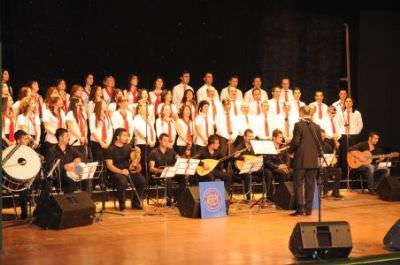
These are forms of music created by people settled in one particular location, played or recited with great affection, which have become the joint creation of the people of the area in question, and which have been passed down and kept alive down to the present day. Such music bears the traces of local cultures, and the names of the composers are generally unknown.
Turkish folk music has combined the distinct cultural values of all those civilisations which have lived in Anatolia and the Ottoman territories in Europe. It is a unique structure which includes regional differences under one umbrella, giving rise to a wealth and variety the like of which can seldom be seen anywhere else in the world. Despite that wide variety from the point of view of regional characteristics, Turkish folk music can broadly be classified into the following seven regional categories: Marmara Region, Aegean, Mediterranean, Central Anatolian ,Souheast, East Anatolian Folksongs and Black Sea Folksongs
Music accompanied by words can be classified under the following headings: Türkü (folksongs), Koşma (free-form folk songs about love or nature), Semai (folk song ın Semai poetic form), Mani (a traditional Turkish quatrain form), Destan (epic), Deyiş (speech), Uzun Hava (long melody), Bozlak (a folk song form), Ağıt (a lament), Hoyrat, Maya (a variety of Turkish folksong), Boğaz Havası (throat tune), Teke Zorlatması, Ninni (lullaby), Tekerleme (a playful form in folk narrative), etc. These are divided into free-forms or improvisations with no obligatory metrical or rhythmic form, known as Uzun Hava, and those which no have a set metrical or rhythmic structure, known as ‘Kırık Havalar,’ (Broken Melodies). Both can also be employed at the same time.
Music generally played without words, and dance tunes, go by the names Halay, Bengi, Karşılama, Zeybek, Horon, Bar etc.
http://www.kultur.gov.tr/EN/Genel/BelgeGoster.aspx?17A16AE30572D313A781CAA92714FCE05620E14DF965E1EB
Ottoman Classical Music
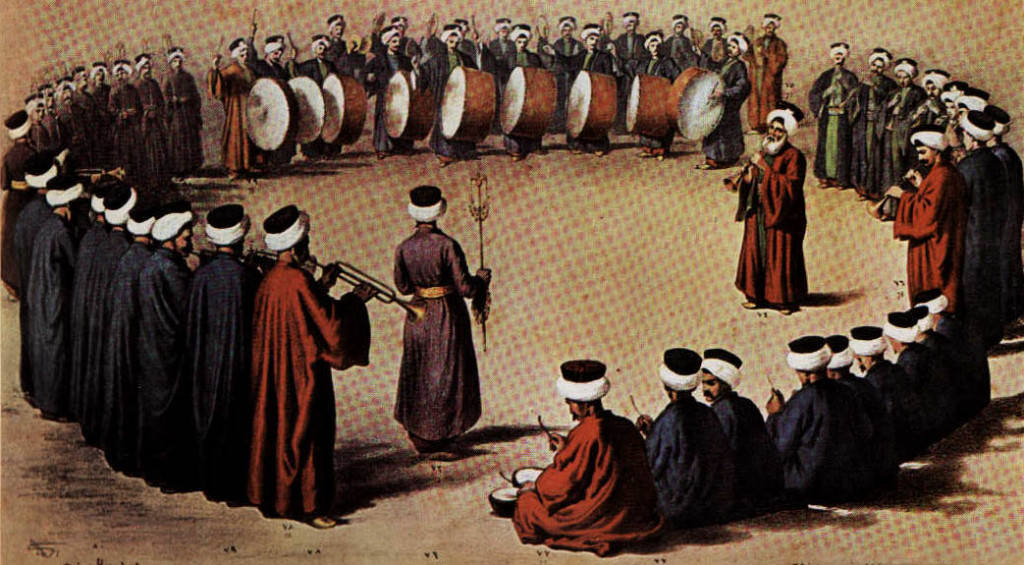
The form of music today generally known as Türk Sanat Müziği, or Ottoman Classical Music, matured, developed in form and aesthetics and came to assume the identity of a form of classical music in parallel to the establishment, growth and increasing strength of the Ottoman state itself. This variety of music furnished products dealing with many subjects, such as religion, love and war. Each of these then came to develop its own varieties, styles and communities. Ottoman music was influenced by other musical cultures as new nations became absorbed into the empire, giving and receiving various elements. The number of works that were written down and have survived down to the present day is some 3,000 for works composed between the 15th century and the end of the 18th. The number produced during the 19th century is around 5,000, giving a total of 8,000. A number of works from the first quarter of the 20th century can also be added to those works, which from the point of view of mode, style, means and methods of vocalisation go back to the very earliest times within a framework of their own distinct rules
Ottoman music is a synthesis, carrying within it a great many historical riches. It emerged as the result of a sharing process between the Turks and the minorities living alongside them, the Byzantines, Greeks, Persians, Arabs, Jews, Armenians etc. It reached its golden age in the private school in the Ottoman palace. No country that employed that system was able to reach the level of artistry attained by the Ottomans.
http://www.kultur.gov.tr/EN/Genel/BelgeGoster.aspx?17A16AE30572D313A781CAA92714FCE02C5153568A09CDD8
Modern Turkish Classical Music
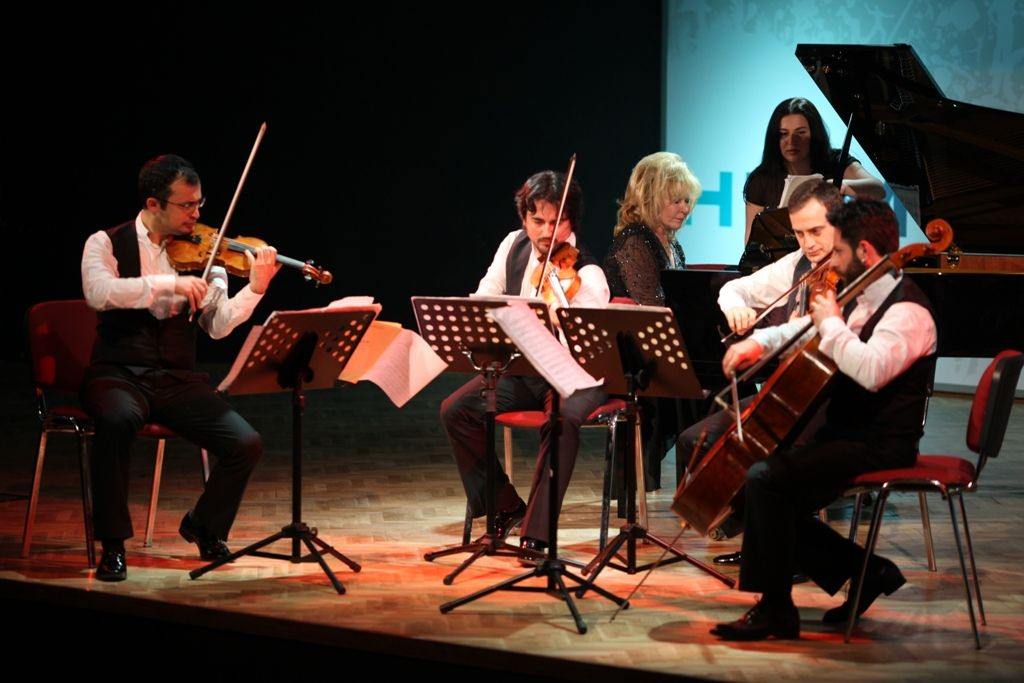
Western influence had already begun to be felt in Ottoman music towards the middle of the 19th century. These increased towards the end of the century, and led to efforts to change Ottoman music from monodic to polyphonic.
With the declaration of the republic in 1923, Cemal Reşid (REY), who was then studying music in Europe, returned to Turkey and began to teach at a music school established in Istanbul. At the same time, a number of talented young people were sent by the republic to various cities in Europe to study music. After they returned to Turkey, the group that would later be called ‘Türk Beşleri’ (the Turkish Five) and which prepared the groundwork for Modern Polyphonic Turkish Music, emerged. The common aim of the group was to use the traditional themes of traditional Turkish music together with the values of Western classical music that they had studied to produce a new polyphonic structure. In later stages, every composer who amed at a more contempoırary sound interpreted the colours and mystery of popular melody in his own way, and instead of merely treating well-known popular melodies they began to achieve syntheses by means of abstraction.
The Turkish Five consisted of; Cemal Reşit REY, Ulvi Cemal ERKİN, Hasan Ferit ALNAR, Ahmet Adnan SAYGUN and Necil Kazım AKSES. Later, others produced and are still producing works in the same field, including; Nuri Sami KORAL, Kemal İLERİCİ, Ekrem Zeki ÜN and Bülent TARCAN of the second generation, Sabahattin KALENDER, Nevit KODALLI, Ferit TÜZÜN, İlhan USMANBAŞ, Bülent AREL and İlhan MİMAROĞLU of the third, and Muammer SUN, Cenan AKIN, Cengiz TANÇ, Kemal SÜNDER, İlhan BARAN, Yalçın TURA and Ali Doğan SİNANGİL of the fourth. An ıncreasing number of other composers after that last generation continue to write works. The current number has now reached around 60.
http://www.kultur.gov.tr/EN/Genel/BelgeGoster.aspx?17A16AE30572D313A781CAA92714FCE04210F2141CE3DF0E
Popular Music
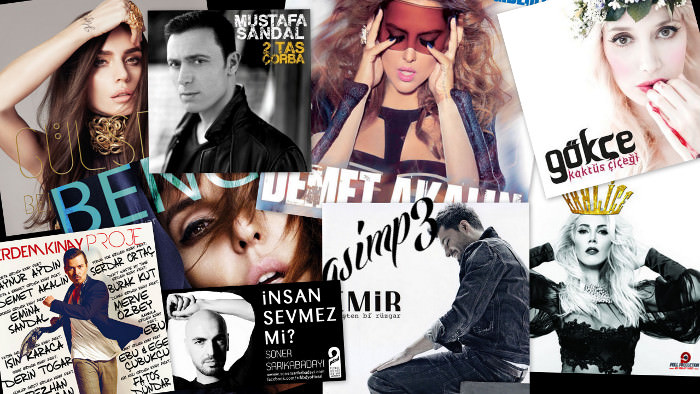
Popular music is to a large extent produced by the consumer generation, or even if not later came on to take on many of those characteristics, and takes its form from the criteria of its own particular sectoral features, in such a way that the values that comprise those criteria are not based on the preferences of the culture of any one section of society, and thus is a form that to a large extent brings together different cultures. In the same way that Europe has seen an industrialised society, the increase in artistic products related to popular culture and their increasing spread in all sections of society, and the efforts towards industrialisation in Turkey and the concomittant rise in urbanisation, have all led to an independent popular cultural atmosphere in society. The basic values that the wide community in which popular culture is influential expects from artistic endeavours can be summed up as easy to understand and comprehend and requiring no great depth, thus calling for no great debate. In Turkey, the products of popular culture have lent colour to the last quarter of the 20th century in particular, and as objects, or from the visual point of view, have called to a wide constituency.
Rapidly changing and progressing cultural formations lead to a suitable environment for the emergence of such products as the artistic works of popular culture. In Turkey, popular culture and the music belonging to it are spreading in this environment with great rapidity in all sections of community. By 2000 it had become powerful enough to respond to the musical tastes of just about all of society.
http://www.kultur.gov.tr/EN/Genel/BelgeGoster.aspx?17A16AE30572D313A781CAA92714FCE053CDC73477F4D04D
Performing Art
Folk Dances
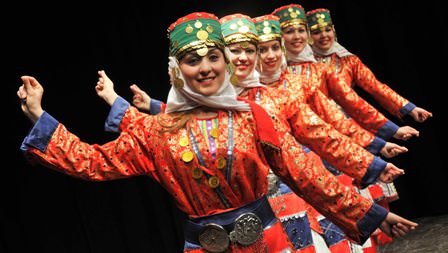
Folk dances are performed at weddings, engagement ceremonies, when sending young men off to perform their military service, at national and religious festivals, after victories, going to and coming back from from the high plateaus and at meetings such as ferfene, yaren talks, barana or sira gezmesi.
Dances are generally performed in all suitable open areas, but may also be performed in close areas as well.
People who enjoy reputations as good folk dancers are especially invited to wedding ceremonies. These are respectable people who have knowledge of that region’s music and folk dances. Folk dances owe their rich variety of moves to such people, who happily improvise while performing in order to show off their skills. In this way, dances are successfully passed on to people who may or may not be capable of dancing themselves, especially the young ones. There are many different types of folk dances performed in various ways in Turkey, and these reflect the cultural structure of each region. The bar in Erzurum province, the halay in the East and Southeast, the hora in Thrace, the horon in the Black Sea and spoon dances in and around Konya are the best known examples of these.
http://www.kultur.gov.tr/EN/Genel/BelgeGoster.aspx?17A16AE30572D313A781CAA92714FCE0AC54D5579D78A331
Folk dances have different characteristics based on region and location and are generally engaged in during weddings, journeys to the mountains in the summer, when sending sons off to military service and during religious and national holidays. The best known folk dances are:
Horon
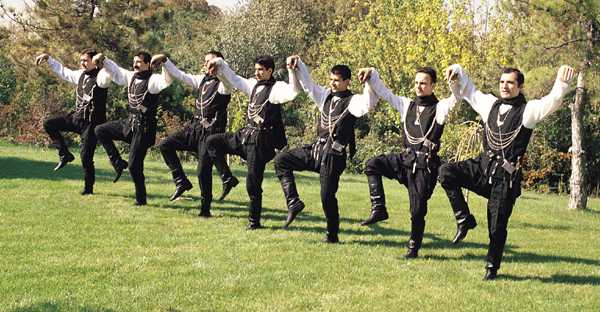
This Black Sea dance is performed by men only, dressed in black with silver trimmings. The dancers link arms and quiver to the vibrations of the kemence, a primitive type of violin.
Kasik Oyunu
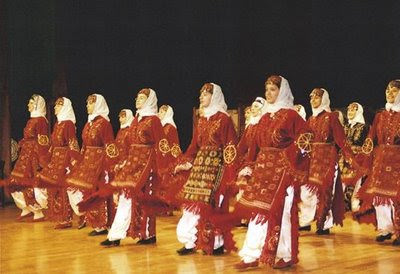
The Spoon Dance is performed from Konya to Silifke and consists of gaily dressed male and female dancers clicking out the dance rhythm with a pair of wooden spoons in each hand.
Kilic Kalkan
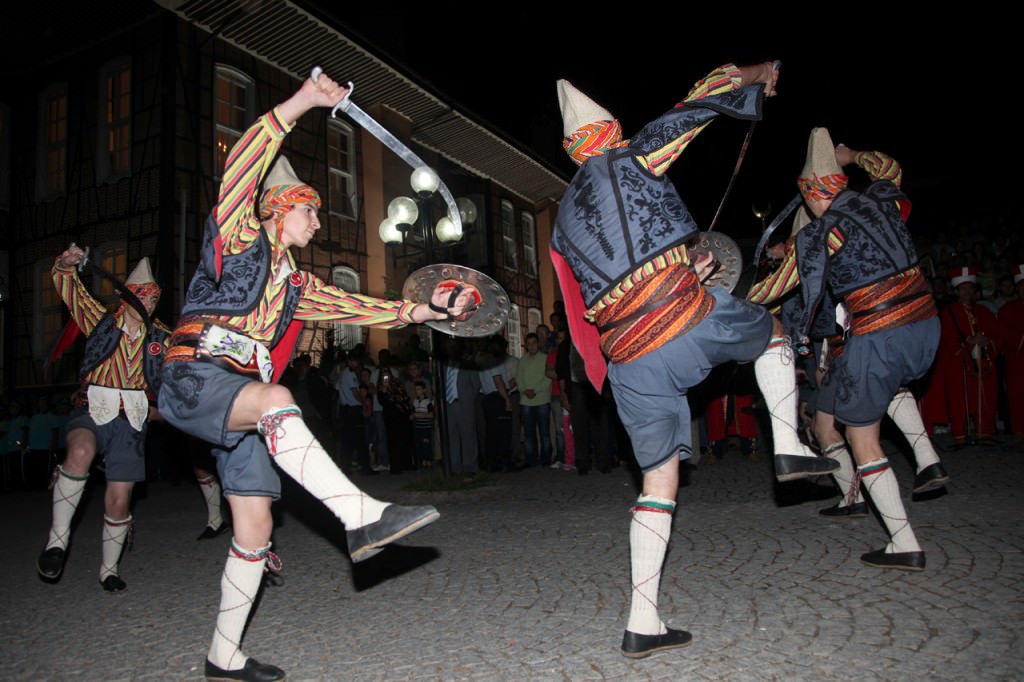
The Sword and Shield Dance of Bursa represents the Ottoman conquest of the city. It is performed by men only, dressed in early Ottoman battle dress, who dance to the sound of clashing swords and shields withoout music.
Zeybek
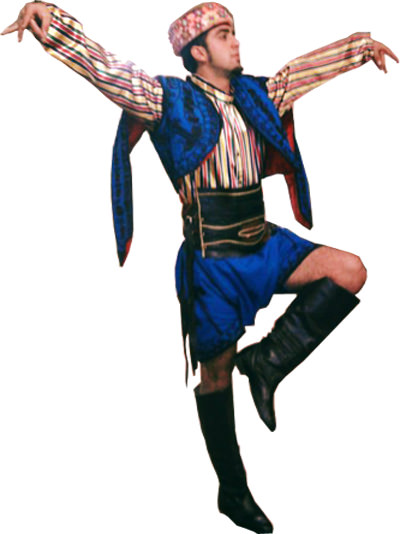
In this Aegean dance, colorfully dressed male dancers, called efe, symbolize courage and heroism.
http://www.turkishconsulategeneral.us/abtturkey/cult/folk.shtml
Traditional Theater
Karagöz
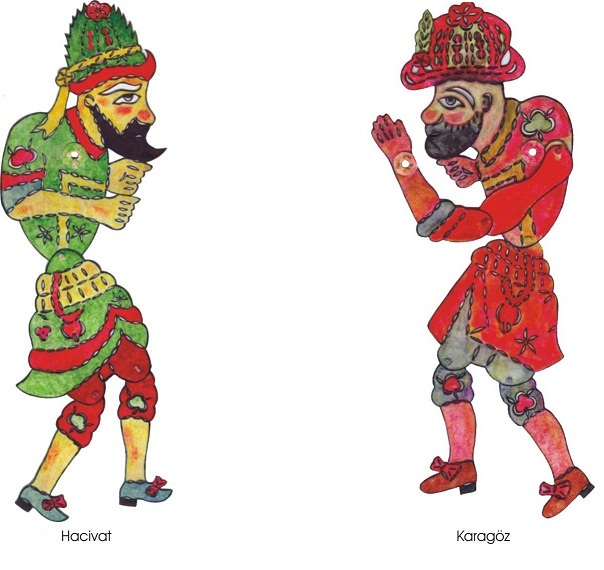
Karagöz is a shadow play whose true form is the moving of beings named as designs made from skin of a camel or cow with sticks on a white curtain by reflecting light behind them. The play takes its name from its main character “Karagöz”.
The source of shadow plays is accepted as southeastern Asian countries. There are different views about it coming to Turkey. One of the views is that the plays such as “ember armlet” and “dream tent” known in Middle East are shadow plays and they’ve been brought to Anatolia during migrations. Other view is that the shadow play has come into Turkey after Yavuz Sultan Selim, who had conquered Egypt in 1517, had brought the shadow play artists to Turkey. Karagöz had become one of the most enjoyed entertainment methods of public, which mainly focused on public types beginning from the 18th century. The subjects of Karagöz plays are funny elements. Double meanings, exaggerations, verbal plays, imitating accents are the main elements of the comedy. The main characters of the play are Karagöz and Hacivat. Karagöz represents the public’s morals and common sense. He speaks as he is. Hacivat is educated in Moslem theology school and he’s unreliable and following the order. The other characters are Tuzsuz (Salties) Çelebi, Drunk, Baberuhi, Albanian, Jewish, Circassian, Kurdish, Laz, Addictive, males taking female parts etc
The studies related to the art of Karagöz that is tried to be continued by a limited number of artists are conducted by the Presidency of Turkey National Center of International Puppet and Shadow Play Union (UNIMA) and the Ministry of Culture.
http://www.kultur.gov.tr/EN/Genel/BelgeGoster.aspx?17A16AE30572D313A79D6F5E6C1B43FF3FCADCC4D22D1E39
Ortaoyunu
The kind of Karagöz, which had been put on stage, had started to develop since 15th century and had gained its dramatic character in the first half of the 19th century. The main characters are Kavuklu and Pişekar. Orta Oyunu, mainly focuses on the speech duet of these two characters. Kavuklu seems to be ignorant and confused and Kurnaz is a merry man from society. Pişekar is an educated and efficient old man who is able to see which is good or bad.
http://www.kultur.gov.tr/EN/Genel/BelgeGoster.aspx?17A16AE30572D313A79D6F5E6C1B43FF2B9C3D5A6EE2A8F5
Meddah
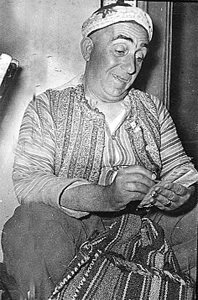
Being a meddah, who is a storyteller, is an art of mimic. It’s a show whose curtain, curtain, stage, decors and costume are only assembled on an artist. Meddah (the storyteller) sits on a chair and tells stories. His subjects are events of daily lives, tales, epics, stories and legends. The accessories of a meddah are a handkerchief and a walking stick. Meddah is the person who makes his story’s characters speak in the language and dialect of his suburb. Meddah is the only artist and player of a theatre work which has more than one players. This art could be seen in the Ottoman Palace, cities, towns on ramadan nights, in circumcision feasts and cates especially when reading was not developed but when listening was more popular. The continuation of this art today is the showmen who make stand-up comedies.
http://www.kultur.gov.tr/EN/Genel/BelgeGoster.aspx?17A16AE30572D313A79D6F5E6C1B43FF54ABFA9F133C5010
Customs and Beliefs
Hospitality
Visitors to Turkey are often pleasantly surprised by the friendliness of the Turkish people, who will go out of their way to assist and happily spend time chatting. Hospitality is a cornerstone of Turkish culture, and Turks believe that visitors should be treated as “Guests sent by God”. This attitude has survived to the 21st century and does not appear to have been diminished by mass tourism. In fact, quite the reverse, most Turks welcome the opportunity to meet foreign visitors, learn about different cultures and practice their language skills. It is usual for Turks – even the men – to greet each other by kissing on both cheeks. As a tradition, Turkish people treat their national flag as sacred. Therefore one should avoid insulting or showing disrespect to the Turkish flag.
http://www.goturkey.com/turkiye.php?lng=en&content=lifestyle
Landmark in Life ( Birth,Wedding,Military)
Birth :
Every child that comes into the world is a source of happiness not just for its mother and father, but also for relatives, friends and neighbors. That is because every birth increases the number of family members, and increased numbers have always meant increased strength. Families belonging to small communities and ethnic groups are in particular feel safer and stronger as their population increases. The common expression ‘children make the family’s kettle whistle’ is a clear emphasis of the importance attached to the matter. Birth, that gives to the mother an identity and completes her, as well as giving confidence to the father and strength to the family, is attributed almost importance by the couple and their relatives. Some transition customs and ceremonies accompany birth and the phases connected to it.
Women who have just given birth are referred to as “loğusa”, “lohsa”, “emzikli”, “loğsa”, “nevse”, or “kırklı”. The length of time a woman who has just had a baby will stay confined to bed depends on her own physiological condition, the question of whether the birth was a difficult or an easy one, climate, environmental considerations and how much the woman is loved by her family.
It is a common belief in Anatolia that women are under the influence of various supernatural forces during accouchement. “The grave of woman in accouchement is open for forty days” (the accouchement period is believed to last forty days), is a saying commonly used in traditional areas that supports this belief. Washing the mother and child within 40 days of birth to prevent them falling ill within that period is known as “making the forties”. It is commonly referred to as “kırklama”, or “kırk dökme” and “kırk çıkarma”.
http://www.kultur.gov.tr/EN/Genel/BelgeGoster.aspx?17A16AE30572D313A781CAA92714FCE0B0B2BEF9CE0ECC93
Wedding :
Young people themselves choose the people whom they will marry after dating them, or the decision is taken together with the family. The prominent women and men from the family visit the girl’s family to ask for her hand according to the command of God and the word of the Prophet at a previously determined sacred date (Thursdays and Sundays are generally considered days of good omen). Yet since the girl’s home is expected to be a place of modesty, the girl’s family does not give its consent on the first visit. A few visits to ask for the girl’s hand are made, giving the family of the girl enough time to think about it. If the family gives its consent, a verbal agreement to betrothal is made. After both sides have completed their preparations, an engagement ceremony is held at the girl’s home, generally with the women in attendance. The man’s family hands over the jewelry and other gifts purchased for the girl; in return, her family also gives presents. The ceremony can include an engagement feast if the sides so wish. The ceremony held one day before the wedding in the home of bride and groom is called the henna night. It generally takes place at the girl’s home and among the women, although either side can elect to host it. Henna that has earlier kneaded with water is brought in on a tray surrounded by candles and placed in the middle of the room. In some places, the henna is first put on the hands of the bride and then distributed to the guests; the other areas the henna is first distributed to the guests, and only after everybody has left it is placed on the bride’s hands. The day after the henna night is the day for receiving the bride and of the main wedding ceremony. Both sides to the wedding offer food to the guests, usually entertaining them to the accompaniment of drums and reeds.The night of the wedding, a small feast is given to the remaining few guests in the house of the groom’s family, and then a religious ceremony is held to marry the couple, presided over by the imam. After the religious ceremony, the couple come together in their own room.
http://www.kultur.gov.tr/EN/Genel/BelgeGoster.aspx?17A16AE30572D313A781CAA92714FCE066FA6A1CE407B291
Military Service :
Military service is deeply rooted in the Turkish culture, and is regarded as a sacred duty. Joining to the army is equated with being an honourable and virtuous person. In rural areas in particular, men who have not performed their military obligations are not well regarded, and what they say is not taken seriously. One of the most widespread practices all over Turkey is for young men who have received their call-up papers to be invited to dine by all their friends and relatives in turn. The young soldier-to-be mat also be entertained with his family. It is also customary for entertainment to be laid on during and after such celebratory meals.
There is great rejoining when a soldier’s military service comes to an end and he returns home. Friends and relatives visit him constantly for up to two weeks, and he is treated as a guest in his own home and not allowed to do any work. In some regions the young man is also given gifts during the course of such visits.
http://www.kultur.gov.tr/EN/Genel/BelgeGoster.aspx?17A16AE30572D313A781CAA92714FCE03F719885B09FDCBF
Traditional Clothes
Turkish traditional dress exhibits tribal and village distinctions while sharing features with Central Asian dress, the dress of the Ottoman Court, and Middle Eastern dress. The common features can be attributed to the cultural contacts of the Turkic peoples over the centuries.
Characteristic features of Turkish traditional dress include the layering of garments, distinctive surface or woven-in decoration on the fabrics, and a geometriccut. Wool, silk, and cotton, fibers indigenous to Turkey, are commonly used for apparel. Separate garments are layered to accommodate the need for adjustments according to climate; to create storage areas for coins and other small items in fabric folds; and to create a system for holding garments onto the body. Common items are the salvar (baggy trouser), gomlek (chemise), ucetek (three-skirted cloak), and elaborate headgear that always includes one or more headscarves for women. Sleeveless vests and waist-length jackets are also common, as are aprons for women.
http://www.bookrags.com/research/clothing-traditionalturkey-ema-02/
In rural areas, women spend most of their time with working. As a result, their daily, work and special day clothes are different. Special costumes and hair dressings are only to be seen at wedding ceremonies. Women’s hair styles differ in accordance with their social status, and whether they are married or engaged, or not. Hair style is an important feature of women’s lives.
http://www.kultur.gov.tr/EN/Genel/BelgeGoster.aspx?17A16AE30572D313A781CAA92714FCE074FDC3CFBB4EF21A
In the Ottoman court, male headdress distinguished social and economic positions. Common in most villages is the baggy trouser (salvar) worn sometimes with a skirt over the top, a long-sleeved blouse or T-shirt, a sweater-vest, and a headscarf. Turkish folk dance groups have kept some of the elaborate dress ensemble traditions alive.
http://www.bookrags.com/research/clothing-traditionalturkey-ema-02/
Lucky Eye and Amulets
The evil eye beads producing is a one of the most famous valuable Turkish master handicraft art. Evil eye beads are made from precious blue glass. People believe that evil eye bead is a power to protect its bearer from the curse of the Evil Eye. Therefor protect themselves from the curse, indigenous peoples have charms and amulets from glass beads with a prominent design in the shape of an eye. This belief came from Mesopotamian culture to Anatolia and all Mediterranean side and spread to Europe and America.
Evil eyes are produced in Gorece, Izmir, Anatolia. Evil eye beads produce by a few masters by use an ancient very special techniques in Turkey(Anatolia). They use a primitive furnaces which is made of clay. They work at approximately 700 degrees for producing beautiful,charming beads. There are no other ways gives these evil eyes jewelry original blue colors and make them charming and unique, precious looking.
http://www.evileyesonline.com/evileyejewelry.html
People who suffer from the evil eye, its effects and characteristics, the act of being stricken by the evil eye, the evil eye and amulets used for protection against it for goods, property and animals, measures taken against the evil eye, talismans such as the muska (a necklace containing hidden prayers) used against evil eye, practices such as pouring lead, turning salt and making incense.
http://www.kultur.gov.tr/EN/Genel/BelgeGoster.aspx?17A16AE30572D313A781CAA92714FCE0022FA740F48B1DD3
Turkish Traditional Sports
Wrestling
After Oghuz branch of Turks migrated to Western Asia and Anatolia, they brought their Central Asian Kurash wrestling style with them. After conquest of Anatolia by Seljuk Turks, they brought their traditional freestyle wrestling called “karakucak” (literally means black hug)and the special leather clothing and initiated usage of olive oil, to make it harder to grap the opponent, from the ancient Western Asian wrestling; and created what is today known as the Yağlı Güreş or Turkish Oil Wrestling.
http://en.wikipedia.org/wiki/Oil_wrestling
“Pehlivan” is a Persian word normally meaning brave, but it also has a number of secondary meanings: officer, governor, a physically large man or a person who tells the truth. Throughout history the word has been used with a variety of meanings. The Seljuks used to employ the word to refer to heroic warriors, accomplished shooters and wrestlers. In the 16th century, it was used exclusively for athletes, and this practice continued to the end of the reign of Sultan Mahmut II. In Ottoman times, wrestling contests were held as a part of festivals and weddings or as a way to raise funds for groups promoting social welfare. In 1946, the Edirne Municipality started organizing the Kırkpınar Wrestling Contest, and in this year also Edirne Mayor Tahsin Şipka added the contest’s organization to the municipality’s official duties.
http://www.kultur.gov.tr/EN/Genel/BelgeGoster.aspx?17A16AE30572D313A781CAA92714FCE009B7BF3A53757A00
Jereed ( Cirit )
Jereed is a traditional Turkish equestrian team sport played outdoors on horseback in which the objective is to score points by throwing a blunt wooden javelin at opposing team’s horsemen. Played by Turkic people in Central Asia as the essential sporting and ceremonial game, it was brought to Anatolia during the westward migration in the beginning of the 11th century. In the Ottoman Empire, the game became very popular and widespread throughout the Ottoman territories. Some of the Ottoman sultans are known to have been jereed players, and early sultans like Bayezid I (1389-1402) and Mehmed I (1413-1421) attached importance to jereed in the training of their armies.
http://en.wikipedia.org/wiki/Jereed
There are two teams in a jereed game. These two teams are placed in rows of 6, 8 or 12 players in a field as much as 70 or 120 meters in length. Jereed players, dressed in regional costumes, mount their horses. With their right hand they hold the first jereed – a long stick – they will throw while holding other jereeds in their left hand. One rider from each side rushes forth towards the opposite side until they are within 30-40 meters of the other side. Then one player shouts the name of a player from the other team, challenging him to enter the game.
He then throws the jereed in his right hand to that player. Later he turns around and he spurs his horse towards his own row. The challenged player from the opposite team follows him and throws a jereed at the player who is running away. Another player from the first row comes out and meets the returning rider. The player from the second row starts riding quickly to his row and takes his former place. This time his rival chases him and throws a jereed at him. The game continues in this manner.
http://www.kultur.gov.tr/EN/Genel/BelgeGoster.aspx?17A16AE30572D313A781CAA92714FCE0DB14E1DB29E18188
Archery
The history of the arrow and bow of the Turks stretches back to very distant times. In the legend of Oguz Khagan it takes its place as both a weapon of war and a symbolic element.
In Central Asia the arrow and bow, together with the sword–whether used in hunting or warfare–was a most important weapon. The sword was used as the primary close-range weapon, and the bow as the primary long-range weapon.
With the acceptance by the Turks of Islam, there was added a special religious significance. In the written sources from the first century of Islam the bow, even more than other weapons, is given a special place.
http://en.wikipedia.org/wiki/Turkish_archery
Archery has been performed as a regular and planned branch of sports in Ottoman Empire since the second half of the 15th century. Thus, there were 34 big arenas specifically assigned to archery activities in the Ottoman period. These places were provided in several cities and were called ‘ok meydani’ (“oq-meidany” arrow-place). Those were the places where the contests and trainings were held while they served as grand facilities where the sportsman live and had their own allocations, managers and staff. There were standing sportive activities under a scheduled order in those arenas.
The most notable of these arrow places was Istanbul Ok-meydani. It was officially donated to archery activities by Mehmed II. (Conqueror) just after the conquest of Istanbul in A.D. 1453. The borders and purpose of use of the field were set clearly by the Sultan’s firman in order to prevent violations such as burial of the dead, entrance of ungulates, construction of houses, agricultural activities. But today, thousands of peoples live in that area and only small parts of guild and some ruins left. Municipality has a plan to restore that area and re-build Guild’s main buildings and shooting area.
http://www.turkisharchery.info/?p=31may
There were several kinds of sportive archery contests in Ottoman. The foremost contest was long distance shooting. It was a fact that Ottoman archers had been shooting to tremendous distances. The second kind of contests was target shooting. Due to the name of targets (Puta), these were called “puta shooting” and the bows used were called “puta bows” and even the arrows were “puta arrows”. The feathers and the forms of those arrows were suitable for target shooting and arrow points in form of olive stones, as it is used today, were common. The most spectacular contests were undoubtedly marksmanship and archery contests. Archery has been performed as a regular and planned branch of sports in the Ottoman Empire since the second half of the 15th century. Thus, there were 34 big arenas specifically assigned to archery activities in the Ottoman period. These places that were provided in several cities were called ‘okmeydanı‘ (“oq-meidany” arrow-place)

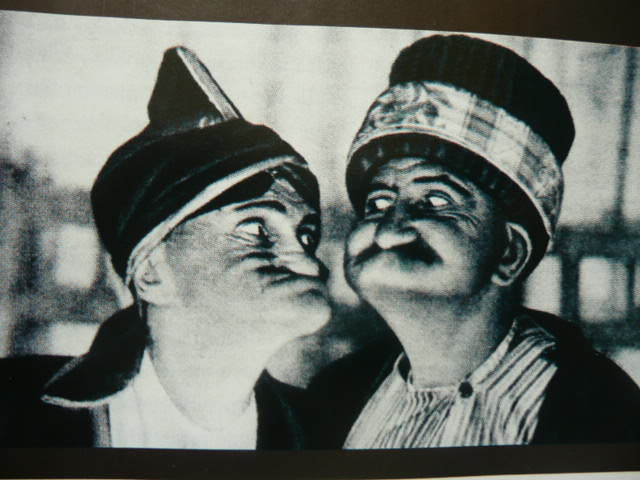
Leave a Reply
You must be logged in to post a comment.